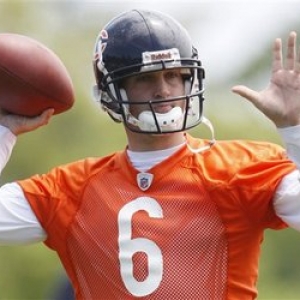Weighing In On The Cutler-Orton Debate
by Trevor Whenham - 7/30/2009
![]()

One of the biggest debates heading into the 2009-10 NFL season is whether the Denver Broncos made the right move by trading away their Pro Bowl quarterback, Jay Cutler. Only time will tell for sure, but it certainly seems like a risky move. It's also a deal that puts Kyle Orton in a very difficult decision - through no fault of his own his every move will be dissected and compared to the man he is replacing.
Cutler has put up the bigger numbers and has had the better career. He also has the bigger expectations upon his shoulders because of what the Bears gave up to get him. Denver obviously feels that Orton is a decent player with some real potential, though - why else would they have made this deal if they didn't? So, which player is likely to be more useful this year - not just to his team, but, more importantly, to us sports bettors? Here's a look at how they compare in six key categories:Lifetime stats - Cutler has completed 62.5 percent of his passes over his career, and has averaged a solid 7.40 yards per attempt. He has 9024 passing yards in less than two and a half seasons in the league. He has 54 touchdowns, and 37 interceptions, or 1.46 touchdowns per interception. His lifetime QB rating is 87.1. Orton has completed just 55.3 percent of his passes, and has averaged a far less impressive 5.83 yards per attempt. He has appeared in just four fewer games than Cutler, yet he has thrown for more than 3700 fewer yards. He has 30 touchdowns compared to 27 interceptions, or 1.11 TDs per pick. His career rating is just 71.1.
Edge: Cutler clearly has a big statistical advantage
Statistical growth - Both men have had two full years as a starting quarterback, though Orton's were separated by two seasons. Cutler improved his passing yardage by 29.4 percent from year one to year two, though his yards per attempt and completion percentage actually fell. He threw five more touchdowns in his second year, though his ratio of TDs to interceptions was slightly better in the first year. Orton's passing yardage increased by more than 59 percent from 2005 to 2008, and his completion percentage and yards per attempt also rose significantly. He went from throwing 0.70 touchdowns per interception in his first season as a starter to 1.5 last year. Incidentally, that 1.5-to-1 ratio is better than Cutler has ever had.
Edge: Orton
ATS performance - Cutler was a terrible bet last year - he was just 4-11-1 ATS. I wish I could say that that was just a blip, but it really wasn't - he was 5-11 ATS the year before. The combination of unrealistic expectations from the betting public, a frustratingly inconsistent team that he was at the helm of, and an inability to really put opponents away has made Cutler one of the truly great burners of money. Orton hardly lit it up last year at just 6-7-2 ATS, but compared to Cutler he was a betting superstar. The Bears were a far more impressive 9-5-2 ATS the last time Orton was a starter for them in 2005.
Edge: Orton
Receivers - Both guys are going to be asked to throw a lot this season, so they will need to rely heavily on their receivers to make them look good. Cutler will have to get used to doing more with less, while Orton will feel like he has died and gone to heaven. Devin Hester is the closest thing to a big play receiver the Bears have on the roster, and he's clearly better receiving kicks than passes. He had 665 receiving yards last year, and caught three TD passes. In contrast, the Broncos had two guys with at least 980 receiving yards, and five guys with three or more TD catches. Chicago is thought to be better at tight end than receiver, but the Broncos even have a statistical edge there.
Edge: Orton
Run support - Both teams ran for 15 touchdowns. Denver piled up more yards, though, and they had a significantly higher average per carry - 4.8 yards versus 3.9 yards. The big difference is in personnel. For Chicago, Matt Forte carried the bulk of the rushing burden, and was a star. He had 73 percent of the team carries, and gained 74 percent of the yards. By contrast, the Broncos were a committee of runners. No back carried as many as 20 percent of the teams carries, and Peyton Hillis led the way with 18.4 percent of the team's yards. Denver has added new personnel to try to add a bit more punch to the running game, but they still lack a likely breakout star.
Edge: Tie. Chicago is more explosive on the run, but Denver has more depth and is therefore more difficult to contain.
Coaching staff - Orton's new staff is very new to the coaching game, and hasn't yet proven to be particularly savvy. Cutler has a well established staff that has enjoyed some success, but has not yet proven that they can make a QB play better than he is, and has shown very little offensive creativity.
Edge: Cutler, but not by much.
Most Recent NFL Handicapping
- Best NFL Teaser Bets Week 17: Basic Strategy Teasers
- 2026 Super Bowl Predictions with Futures Odds
- NFL Betting Predictions: Week 17 Opening Line Report and Picks
- Best NFL Teaser Bets Week 16: Basic Strategy Teasers
- NFL Betting Predictions: Week 16 Opening Line Report and Picks
- Best Bets and Predictions for Super Bowl Futures Odds
- Best NFL Teaser Bets Week 15: Basic Strategy Teasers
- NFL Betting Predictions: Week 15 Opening Line Report and Picks
- Best NFL Teaser Bets Week 14: Basic Strategy Teasers
- NFL Betting Predictions: Week 14 Opening Line Report and Picks
